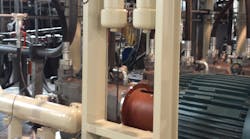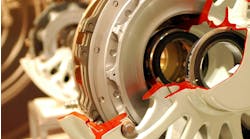An overwhelming amount of technical documentation presents valuable advice on such topics as the importance of keeping hydraulic fluid clean and why you should change the filters on a regular basis. These basics are second-nature to most hydraulics engineer and technicians. Although basic practices cannot be overlooked, executing best practices can move hydraulic contamination control to the next level.
Fluid cleanliness. Ensure that any fluid is filtered before it goes into the hydraulic reservoir. Fresh hydraulic fluid often is not clean enough to put into a system. So if you can’t verify that the fluid has been filtered to your system’s specifications, run it through a filter before transferring it into the reservoir.
Monitor fluid condition regularly. This means use laboratory-grade analysis on a schedule determined by the operating conditions, not an arbitrary timetable. Always flush a system to manufacturer’s specifications or in line with ISO standards every time components are replaced or repairs performed.
1. A high-pressure filter with visual and electrical indicator is mounted directly downstream of a pump in the hydraulic system’s HPU. The hydraulic system actuates a weir, or gate, in a dam that lets municipal workers control water level in a small lake.
Filter maintenance. Monitor the filters and change them before they go into bypass mode. Again, this requires a schedule based on the operating conditions, not an arbitrary timetable. Make sure replacement filter elements comply with the original manufacturer’s specifications.
Filters sourced from the original source always represent the best choice. “Equivalent” filters may not be acceptable substitutes for verified laboratory testing and qualification. In addition, you should scrutinize reservoir breathers, as they also act as filters. Unless the system is installed in a clean room, airborne contamination can be a major issue.
Filter location. In almost all cases, do not locate filters at pump inlets. As a filter becomes clogged with dirt, it restricts flow, which can starve a hydraulic pump for fluid. When this happens, cavitation can occur, which poses a much greater risk to premature pump failure than contamination does.
Filters should not be placed on the drain lines of piston pumps and motors. These lines need to be free-flowing. If they become blocked or restricted, the piston pump or motor can suffer premature failure. The best place for fine filtration is generally on the return side of the system. If the fluid is clean initially, any contamination will be generated within the system and caught by a return line filter.
Implementing these practices covers the basics. However, to truly maximize the return on a hydraulic investment, more in-depth considerations must be applied that go beyond the basics. So let’s revisit each of these basic topics, but dig deeper to discover some best practices.
2. An off-line (kidney-loop) filter assembly uses an electric motor and centrifugal pump to circulate oil from a hydraulic system’s main reservoir, through a low-pressure filter, and back to the reservoir.
Fluid Cleanliness
Much of today’s hydraulic equipment require higher operating pressures. In line with this is the need for higher cleanliness levels. In the past, ISO 4406 cleanliness code 19/17/15 may have been acceptable. However, it’s not unusual for today’s high-performance hydraulic systems to require ISO 4406 5/13/10 or even higher. Maintaining these high levels will probably require more than periodic laboratory analysis of the fluid.
A solution growing in use is a “Laboratory in a Suitcase” for testing fluid contamination in the field. Eaton and other suppliers offer highly capable units that will allow testing at frequent intervals without incurring the costs associated with an external laboratory. If monitoring must be more advanced, then an inline particle counter can be installed to provide real-time monitoring of fluid contamination.
These devices use a variety of technologies to monitor the fluid condition and generate an alarm when anomalies are detected. Inline water sensors are also available to monitor moisture and free water in hydraulic and lubricating oils. Multiple condition monitoring data points can provide users with a comprehensive view of the system health, including trends over predetermined periods.
3. A hydraulic system powering an industrial press uses two high-pressure filters downstream of the system’s main hydraulic pumps to protect valves, actuators, and other critical components from contamination.
Filter Maintenance
Many in-operation challenges can be reduced or eliminated by adopting a proactive system design strategy. One example of this is applying thinking to where any required suction filters are mounted. Installing them outside the reservoir simplifies maintenance. In reality, suction strainers and filters mounted inside the reservoir are seldom or never cleaned or replaced.
Another area that should come into focus is the use of manifolds and tank-top filters. Both of these can reduce maintenance costs. Manifolds and tank-top filters also reduce the number of potential contamination ingression points, making the system cleaner and more reliable.
Designers should always avoid specifying filters purely based on maximum published flow rates. Maximum flow rates are purely a measure of what the filter can handle without damage to the element. They are most definitely not the flow rates at which the filter can be expected to deliver maximum cost-effective performance.
Other factors, such as fluid viscosity changes and cold-start conditions, also impact filter performance and life. Eaton recommends that hydraulics filters be sized for twice the desired maximum flow rate. Doing so will optimize filtration performance, decrease downtime, and reduce a machine’s total cost of ownership.
We also suggest that filters should be equipped with differential pressure gauges or switches. Comparing the inlet pressure to the outlet pressure gives a good indication of how much dirt is in a filter element. Switch-type units can be hard-wired to a warning light, audible alarm, or other device. This will proactively notify maintenance personnel of an approaching end-of-life condition before the filter goes into bypass mode.
Although we have already discussed breathers, they warrant a second look. A typical low-cost breather uses a non-replaceable, 10-µm paper element. This means a lot of 10-µm particles will be allowed into the reservoir. Experience says that if one 10-µm particle goes into the pump, two will come out. Yes, the return line filter will capture them both, but the damage has been done at that point, and the pump’s useful life has been shortened. Spending a few dollars for an effective breather—and maintaining it like every other filter in the system—will prevent the damage in the first place.
4. A low-pressure kidney-loop circuit can provide continuous filtration of fluid, even when the hydraulic system is not operating. This method often is used in applications with an extremely high potential for contamination ingression. Operating the circuit during an off shift can clean the fluid to near-pristine condition for the start of the next work shift.
Filter Location
The best location for filters is generally on the return side of the system. The advantage here is that a finer filter can be installed in this location. This means that any flow restriction is less likely to impact pumps, motors, and valves.
OEMs seeking an even more cost-effective approach can usually design out most of the active loop filtration system entirely. This is done by designing in and off-line (kidney-loop) filtration circuit. This is a stationary system that continuously filters fluid in the reservoir. This approach has several advantages.
- A kidney loop does not need to operate at high pressure and can, therefore, use less-expensive filters.
- It can be shut down for filter maintenance with no impact on system operation.
- It usually can achieve efficient laminar flow to maximize filter performance.
- It can easily incorporate a low-pressure oil cooler to moderate fluid temperature.
- A kidney loop does not require exceptionally fine filtration because it continuously cleans the fluid. Typical systems use a 25-µm element on the pressure side and a 10-µm element on the return while maintaining specified fluid cleanliness levels.
Wrapping it Up
Implementing techniques beyond the basic foundations will pay dividends in terms of an optimized system performance, minimized operating cost and eliminated maintenance problems. It is worth the effort from an engineering standpoint and produces economic payoffs by drastically reduce total cost of ownership.
Justin Bitner is product manager, Eaton Filtration, Eden Prairie, Minn.






